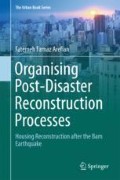Abstract
Plans on how to organise a programme or project are made prior to their actual implementation, when initial assumptions are made while the available information is often limited in the early stages. Corrective adjustments thus are needed over time to reflect the realities of the implementation of the programme. The reconstruction period is already uncertain and dynamic thus upon implementation some initial assumptions be proved problematic and new information or situation regularly emerges. The sociotechnical system for delivery of the strategic objectives of the housing reconstruction programme in Bam provides an illustrative example of a participatory reconstruction programme evolution over the official period of reconstruction, and the variety of the influential drivers of that. This chapter explores the system adjustments of the Bam’s urban housing reconstruction programme in response to the emerging issues and forcing drivers either as a result of the initial design of the system or the emerged realities in the field and its broader context. A few examples are adjustments in control mechanisms, introducing creative solutions to an operational bottleneck, changing the role of beneficiaries and the way the programme towards the end of the programme the system was downsized to mark the end of the reconstruction period. The organisational capacity was adjustable in order to address the unknown pace of participatory reconstruction activities. These adjustments also reflected a major political change in the country that influenced the internal dynamics of some participant organisations and introduced a new group of beneficiaries, increasing the size of the programme.
Access this chapter
Tax calculation will be finalised at checkout
Purchases are for personal use only
Notes
- 1.
The Country’s Engineering Organisation (CEO) qualifies engineers as architects in three grades based on their experiences. It starts with grade three for younger engineers with 3 years work experience after graduation. Grade one is for engineers and architects with 15 years of experience after their graduations.
- 2.
Kashmar is a town in Razavi Khorasan Province, northeast Iran.
- 3.
Mashhad is the capital of the Razavi Khorasan Province, northeast Iran.
- 4.
The new president (Mahmood Ahmadinejad) was elected on 3 August 2005.
References
Alizamani MH (2012) Contemporary approaches in post disaster housing reconstruction (Unpublished PowerPoint file presented at various conferences) (in Persian)
Arefian F (2016) Getting ready for urban reconstruction: organising housing reconstruction in Bam. In: Arefian FF, Moeini SHI (eds) Urban change in Iran: stories of rooted histories and ever-accelerating developments. The urban book series. Springer International Publishing, Cham, Heidelberg, New York, Dordrecht, London, pp 231–257
Coppola DP (2006) Introduction to international disaster management, 1st edn. Butterworth-Heinemann
Davis I (2007) Learning from disaster recovery; guidance for decision makers. International Recovery Platform (IRP). http://www.undp.org.cu/crmi/docs/irp-decmakersleslearned-td-2006-en.pdf. Accessed 17 Nov 2010
Hamdi N (2010) The placemaker’s guide to building community. Earthscan Publications, London, Washington DC
HFIR (2005) Guidance for reconstruction, residential, retail and public units of Bam, Baravat and surrounding villages, 2nd edn. Housing Foundation Islamic Revolution, Bam (in Persian)
HFIR (2012a) Documenting the reconstruction of Bam, role and function of governments, international agencies and NGOs in reconstruction (focusing on Housing Reconstruction) (Unpublished report) (in Persian)
HFIR (2012b). Documenting the reconstruction of Bam: design process in reconstruction (Unpublished report) (in Persian)
HFIR (n.d.) Deputy of reconstruction and rural housing (Website). Housing foundation of Islamic revolution. http://www.bonyadmaskan.ir/En/sitepages/Deputy%20of%20Recontruction%20and%20Rural%20Housing.aspx. Accessed 09 Sept 2013
HFIR (n.d.) Bonyadmaskan—English page (Website). http://www.bonyadmaskan.com/portal/Home/Default.aspx?Categoryid=e181864e-8d8d-4c9d-991d-b1668e0e9219. Accessed 03 June 2011
Hidellage V, Usoof A (2010) Scaling-up people-centred reconstruction: lessons from Sri Lanka’s post-tsunami owner-driven programme. In: Lyons M, Schilderman T, Boano C (eds) Building back better: delivering people-centred housing reconstruction at scale. Practical Action Pub, Warwickshire, pp 77–112
Jha AK, Barenstein JD, Phelps PM, Pittat D, Sena S (2010a) Chapter 13, Institutional options for reconstruction management. In: Safer homes, stronger communities: a handbook for reconstructing after natural disasters. World Bank, New York, pp 197–207. http://www.housingreconstruction.org/housing/toc. Accessed 11 Jan 2011
Jha AK, Barenstein JD, Phelps PM, Pittat D, Sena S (2010b) Chapter 6, Reconstruction approaches. In: Safer homes, stronger communities: a handbook for reconstructing after natural disasters. World Bank, New York, pp 93–107. http://www.housingreconstruction.org/housing/toc. Accessed 11 Jan 2011
Johnson C (2007) Strategic planning for post-disaster temporary housing. Disasters 31(4):435–458. https://doi.org/10.1111/j.1467-7717.2007.01018.x
Joodi M (2010) A brief review on Bam reconstruction program. Presented in International Recovery Forum 2010, organised by International Recovery Platform (IRP), 16/01/2010, Kobe Japan. http://www.recoveryplatform.org/resources/meetings_and_trainings/514/international_recovery_forum_2010. Accessed 23 Dec 2010
Lyons M, Schilderman T, Boano C, D’Urzo S (2010) Conclusions. In: Lyons M, Schilderman T, Boano C (eds) Building back better: delivering people-centred housing reconstruction at scale. Practical Action Pub, Warwickshire UK, pp 345–359
Meskinazarian A (2011) Social resilience of post-earthquake Bam. PhD thesis, Department of Geography, King’s College London, London, UK
ORA (Office of Reconstruction Affairs) (2004 to 2007) Weekly physical work progress reports, prepared by Setads from 2004 to 2007 (unpublished reports from HFIR archive)
Saemian S, Erfanian Daneshvar A (2011) The process of technical control and supervision in reconstruction of Bam. (Unpublished report). (in Persian)
Sull DN (2007). Closing the gap between strategy and execution. MIT Sloan Manage Rev 48(4). http://sloanreview.mit.edu/the-magazine/articles/2007/summer/48412/closing-the-gap-between-strategy-and-execution/?type=x&reprint=48412. Accessed 19 Jan 2011
Wilford J (2008) Out of rubble: natural disaster and the materiality of the house. Environ Plann D 26(4):647–662. https://doi.org/10.1068/d4207
Author information
Authors and Affiliations
Corresponding author
Rights and permissions
Copyright information
© 2018 Springer International Publishing AG
About this chapter
Cite this chapter
Arefian, F.F. (2018). Implementation and the Dynamic Evolution of the Bam Housing Reconstruction Organisation. In: Organising Post-Disaster Reconstruction Processes. The Urban Book Series. Springer, Cham. https://doi.org/10.1007/978-3-319-70911-6_6
Download citation
DOI: https://doi.org/10.1007/978-3-319-70911-6_6
Published:
Publisher Name: Springer, Cham
Print ISBN: 978-3-319-70910-9
Online ISBN: 978-3-319-70911-6
eBook Packages: Earth and Environmental ScienceEarth and Environmental Science (R0)

